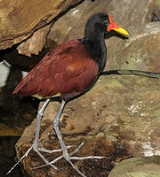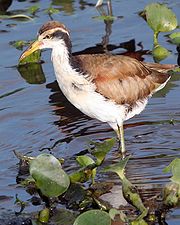
Wattled Jacana
Encyclopedia
The Wattled Jacana Jacana jacana is a wader
which is a resident breeder from western Panama
and Trinidad
south through most of South America
east of the Andes.
The jacana
s are a group of wetland bird
s, which are identifiable by their huge feet and claws that enable them to walk on floating vegetation in the shallow lakes that are their preferred habitat. They are found worldwide within the tropical zone.
The Wattled Jacana lays four black-marked brown eggs in a floating nest. The male, as with other jacanas and some other wader families like the phalarope
s, takes responsibility for incubation, with two eggs held between each wing and the breast. The females are polyandrous
, and will help to defend the nests of up to four mates.
These are conspicuous and unmistakable bird
s. They are 17-23 cm long, but the females are larger than the males. The adults have a chestnut back and wing coverts, with the rest of the body mainly black. In flight the greenish yellow flight feathers are obvious. The yellow bill extends up as a red coot
-like head shield and a reddish wattle, and the legs and very long toes are dull blue-grey. There is a long sharp spur on the bend of the wing.
 Young birds initially have entirely white underparts, and can always be identified by the presence of white in their plumage.
Young birds initially have entirely white underparts, and can always be identified by the presence of white in their plumage.
There are six races, with the nominate J. j. jacana being the most widespread. Several of the other subspecies are similar, but J. j. hypomelaena of western Panama and northern Colombia
has all the chestnut plumage replaced by black, and J. j. scapularis of western Ecuador
has some black feathers on its chestnut shoulders, and white outer primary feathers.
This species produces a range of noisy rattling calls.
The Wattled Jacana's food is insect
s, other invertebrates and seeds picked from the floating vegetation or the water’s surface.
Jacana
is Linnæus' scientific Latin
spelling of the Brazilian Portuguese jaçanã, pronounced ʒasaˈnɐ̃, from the Tupi
name of the bird.
Wader
Waders, called shorebirds in North America , are members of the order Charadriiformes, excluding the more marine web-footed seabird groups. The latter are the skuas , gulls , terns , skimmers , and auks...
which is a resident breeder from western Panama
Panama
Panama , officially the Republic of Panama , is the southernmost country of Central America. Situated on the isthmus connecting North and South America, it is bordered by Costa Rica to the northwest, Colombia to the southeast, the Caribbean Sea to the north and the Pacific Ocean to the south. The...
and Trinidad
Trinidad
Trinidad is the larger and more populous of the two major islands and numerous landforms which make up the island nation of Trinidad and Tobago. It is the southernmost island in the Caribbean and lies just off the northeastern coast of Venezuela. With an area of it is also the fifth largest in...
south through most of South America
South America
South America is a continent situated in the Western Hemisphere, mostly in the Southern Hemisphere, with a relatively small portion in the Northern Hemisphere. The continent is also considered a subcontinent of the Americas. It is bordered on the west by the Pacific Ocean and on the north and east...
east of the Andes.
The jacana
Jacana
The jaçanas are a group of tropical waders in the family Jacanidae. They are found worldwide within the tropical zone. See Etymology below for pronunciation....
s are a group of wetland bird
Bird
Birds are feathered, winged, bipedal, endothermic , egg-laying, vertebrate animals. Around 10,000 living species and 188 families makes them the most speciose class of tetrapod vertebrates. They inhabit ecosystems across the globe, from the Arctic to the Antarctic. Extant birds range in size from...
s, which are identifiable by their huge feet and claws that enable them to walk on floating vegetation in the shallow lakes that are their preferred habitat. They are found worldwide within the tropical zone.
The Wattled Jacana lays four black-marked brown eggs in a floating nest. The male, as with other jacanas and some other wader families like the phalarope
Phalarope
A phalarope or wadepiper is any of three living species of slender-necked shorebirds in the genus Phalaropus of the bird family Scolopacidae. They are close relatives of the shanks and tattlers, the Actitis and Terek Sandpipers, and also of the turnstones and calidrids...
s, takes responsibility for incubation, with two eggs held between each wing and the breast. The females are polyandrous
Polyandry
Polyandry refers to a form of marriage in which a woman has two or more husbands at the same time. The form of polyandry in which a woman is married to two or more brothers is known as "fraternal polyandry", and it is believed by many anthropologists to be the most frequently encountered...
, and will help to defend the nests of up to four mates.
These are conspicuous and unmistakable bird
Bird
Birds are feathered, winged, bipedal, endothermic , egg-laying, vertebrate animals. Around 10,000 living species and 188 families makes them the most speciose class of tetrapod vertebrates. They inhabit ecosystems across the globe, from the Arctic to the Antarctic. Extant birds range in size from...
s. They are 17-23 cm long, but the females are larger than the males. The adults have a chestnut back and wing coverts, with the rest of the body mainly black. In flight the greenish yellow flight feathers are obvious. The yellow bill extends up as a red coot
Coot
Coots are medium-sized water birds that are members of the rail family Rallidae. They constitute the genus Fulica. Coots have predominantly black plumage, and, unlike many of the rails, they are usually easy to see, often swimming in open water...
-like head shield and a reddish wattle, and the legs and very long toes are dull blue-grey. There is a long sharp spur on the bend of the wing.

There are six races, with the nominate J. j. jacana being the most widespread. Several of the other subspecies are similar, but J. j. hypomelaena of western Panama and northern Colombia
Colombia
Colombia, officially the Republic of Colombia , is a unitary constitutional republic comprising thirty-two departments. The country is located in northwestern South America, bordered to the east by Venezuela and Brazil; to the south by Ecuador and Peru; to the north by the Caribbean Sea; to the...
has all the chestnut plumage replaced by black, and J. j. scapularis of western Ecuador
Ecuador
Ecuador , officially the Republic of Ecuador is a representative democratic republic in South America, bordered by Colombia on the north, Peru on the east and south, and by the Pacific Ocean to the west. It is one of only two countries in South America, along with Chile, that do not have a border...
has some black feathers on its chestnut shoulders, and white outer primary feathers.
This species produces a range of noisy rattling calls.
The Wattled Jacana's food is insect
Insect
Insects are a class of living creatures within the arthropods that have a chitinous exoskeleton, a three-part body , three pairs of jointed legs, compound eyes, and two antennae...
s, other invertebrates and seeds picked from the floating vegetation or the water’s surface.
Jacana
Jacana
The jaçanas are a group of tropical waders in the family Jacanidae. They are found worldwide within the tropical zone. See Etymology below for pronunciation....
is Linnæus' scientific Latin
Binomial nomenclature
Binomial nomenclature is a formal system of naming species of living things by giving each a name composed of two parts, both of which use Latin grammatical forms, although they can be based on words from other languages...
spelling of the Brazilian Portuguese jaçanã, pronounced ʒasaˈnɐ̃, from the Tupi
Old Tupi language
Old Tupi or Classical Tupi is an extinct Tupian language which was spoken by the native Tupi people of Brazil, mostly those who lived close to the sea. It belongs to the Tupi–Guarani language family, and which has a written history spanning the 16th, 17th and early 18th centuries...
name of the bird.
External links
- Wattled Jacana videos, photos & sounds on the Internet Bird Collection

